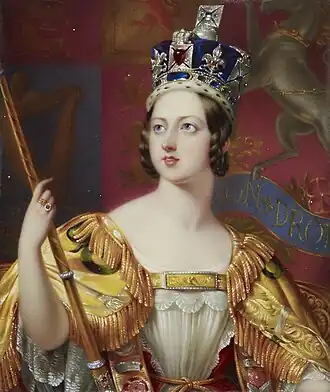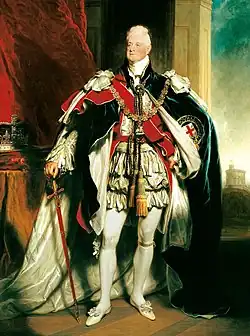1837 in the United Kingdom
| 1837 in the United Kingdom |
|---|
| Other years |
| Constituent countries of the United Kingdom |
| England | Ireland | Scotland | Wales |
| Sport |
| 1837 English cricket season |
Events from the year 1837 in the United Kingdom. This marks the beginning of the Victorian era.
Incumbents
- Monarch – William IV (until 20 June), Victoria (starting 20 June)
- Prime Minister – William Lamb, 2nd Viscount Melbourne (Whig)
- Foreign Secretary – Henry John Temple, 3rd Viscount Palmerston
Events

- January–February – Serious influenza outbreak.[1]
- 11 January – The Royal Institute of British Architects in London (RIBA) is granted its royal charter.
- 13 February – Rowland Hill's government inquiry into postal reform discusses the idea of carrying letters in a separate sheet which folds to become an envelope and the idea of "a bit of paper" which could be affixed to a letter to flag that postage had been prepaid.
- March – A new city in the Australian colonies is named for Lord Melbourne, the Prime Minister.[2]
- 1 March–31 May – At only 5.63 °C (42.13 °F) Central England temperature, the coolest English spring on record; this remains the last recorded coolest traditional season in the CET series.[3]
- c. June – Smallpox epidemic of 1837–40 breaks out.[1]
- 1 June – The Government-funded Normal School of Design, predecessor of the Royal College of Art, begins classes at Somerset House in London.
- 3 June – The Kensington Hippodrome opens in Notting Hill.
- 12 June – Cooke and Wheatstone file their patent for the electrical telegraph.[4]
- 20 June – King William IV dies from heart failure at Windsor Castle with Queen Adelaide at his bedside. Due to none of his nine surviving children being legitimate,[5] his 18-year-old niece, Princess Victoria of Kent, ascends the throne as Queen Victoria.[6] At 6am, Francis Conyngham, 2nd Marquess Conyngham (Lord Chamberlain) and William Howley (Archbishop of Canterbury) call on her at Kensington Palace to break the news. She will reign for 63 years.[6] Under Salic law, the Kingdom of Hanover passes to William's brother, Ernest Augustus, Duke of Cumberland, ending the personal union of Britain and Hanover which has persisted since 1714.
- 30 June – The use of the pillory as a punishment is abolished by act of parliament.[7]
- 1 July – General Register Office begins the practice of registering births, marriages and deaths in England and Wales.[7]
- 3 July – Wills Act clarifies the procedure for making a valid will with effect from 1 January 1838.
- 13 July – Queen Victoria moves from Kensington Palace into Buckingham Palace, the first reigning British monarch to make this, rather than St James's Palace, their London home.[7]
- 19 July
- The Isambard Kingdom Brunel-designed steamship SS Great Western is launched in Bristol.[7]
- The first missionaries sent abroad by the Church of Jesus Christ of Latter-day Saints land from the United States at Liverpool. On 30 July, apostle Heber C. Kimball baptises the first English converts (George D. Watt and 8 others) in the River Ribble near Preston, Lancashire.[8]
- 20 July – Euston Station, London's first mainline railway terminus, is opened.[7]
- 24 July–18 August – A General election results in a Whig victory.[2]
- 17 August – John Kent becomes Britain's first black police officer on joining the constabulary in Carlisle.
- 28 August – Lea & Perrins begin making Worcestershire sauce.[7][9]
- October – Alleged first sighting of a Spring-heeled Jack, in London.
- 9 November – Stockbroker Moses Montefiore becomes the first Jew to receive a knighthood.[7]
- 15 November – Isaac Pitman publishes Pitman Shorthand.[7]
Undated
- Burglary, arson and "shooting at" cease to be capital crimes.[10]
- Joseph Paxton designs the Great Conservatory or Stove at Chatsworth House; it is the world's largest glass building at this time.[11]
Publications
- Richard Harris Barham's The Ingoldsby Legends 'by Thomas Ingoldsby' begin to appear in serial form in Bentley's Miscellany.
- Thomas Carlyle's book The French Revolution: A History.
- Charles Dickens' novel Oliver Twist appears in serial form in Bentley's Miscellany (from February).[6]
- Robert Southey's "The Story of the Three Bears" appears in The Doctor.
- Martin Tupper's book Proverbial Philosophy.
- Andrew Ure's encyclopedia A Dictionary of Arts, Manufactures and Mines.
Births

- 7 January – Thomas Henry Ismay, shipowner (died 1899)
- 30 January – Augusta Webster, born Julia Augusta Davies, poet (died 1894)
- 7 February – James Murray, lexicographer (died 1915)
- 23 March – Charles Wyndham, actor and theatrical manager (died 1919)
- 5 April – Algernon Charles Swinburne, poet (died 1909)
- 7 April – Gilbert Arthur à Beckett, writer (died 1891)
- 28 May – George Ashlin, architect (died 1921)
- 9 June – Anne Isabella Thackeray Ritchie, novelist and essayist (died 1919)
- 14 November – Lucas Barrett, naturalist (died 1862)
- 23 November – Joseph Leycester Lyne, Anglican Benedictine abbot (died 1908)
- 5 December – Richard Thomas, tin plate manufacturer (died 1916)
- 26 December – William Boyd Dawkins, geologist (died 1929)
Deaths

- 20 January – Sir John Soane, British architect (born 1753)
- 23 January – John Field, Irish composer (born 1782)
- 31 January – John Rolls of The Hendre, judge (born 1776)
- 1 February – Edward Donovan, writer, traveller and amateur zoologist (born 1768)
- 19 February – Thomas Burgess author, philosopher and Bishop (born 1756)
- 31 March – John Constable, painter (born 1776)
- 31 May – Joseph Grimaldi, clown (born 1778)
- 20 June – William IV (born 1765)
- 24 June – Henry Thynne, 3rd Marquess of Bath, naval officer and politician (born 1797)
- 1 August – Walter Geikie, painter (born 1795)
- 22 September – William George Horner, mathematician (born 1786)
- 7 December – Robert Nicoll, poet (born 1814)
References
- ^ a b Creighton, Charles (1894). A History of Epidemics in Britain. Vol. II. Cambridge University Press.
- ^ a b Palmer, Alan; Palmer, Veronica (1992). The Chronology of British History. London: Century Ltd. pp. 261–263. ISBN 0-7126-5616-2.
- ^ Met Office, Hadley Center ranked seasonal CET.
- ^ van Dulken, Stephen (2001). Inventing the 19th Century. London: British Library. pp. 82–3. ISBN 0-7123-0881-4.
- ^ "William IV (1765-1837)". History. BBC. Retrieved 13 December 2011.
- ^ a b c "Icons, a portrait of England 1820–1840". Archived from the original on 22 September 2007. Retrieved 12 September 2007.
- ^ a b c d e f g h Penguin Pocket On This Day. Penguin Reference Library. 2006. ISBN 0-14-102715-0.
- ^ "History of the Church in the British Isles". The Church of Jesus Christ of Latter-day Saints. 2013. Retrieved 10 June 2014.
- ^ Some sources give 1838 as the year it was first marketed, e.g. "Worcester Sauce". BirminghamUK.com. Retrieved 15 November 2010.
- ^ "Timeline of capital punishment in Britain". Retrieved 2 February 2011.
- ^ Hitchcock, Henry-Russell (1977). Architecture: Nineteenth and Twentieth Centuries. Harmondsworth: Penguin Books. p. 177. ISBN 0-14-056115-3.